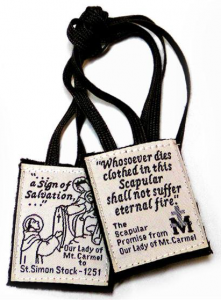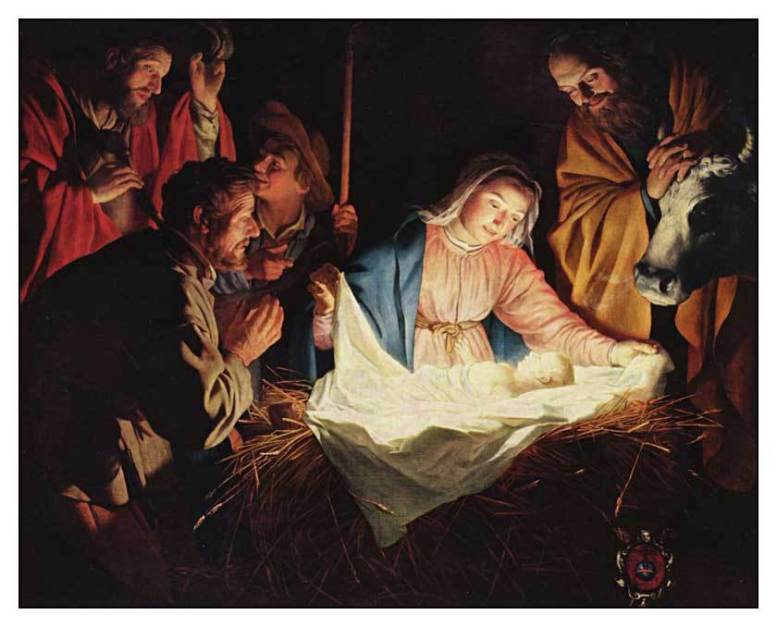A Garment That Protects You From Evil
A Garment That Protects You From Evil
 Last week, in my article titled Secrets of a Dying Man, I asked you to imagine finding a seriously wounded man on the side of the road. I then wrote,
Last week, in my article titled Secrets of a Dying Man, I asked you to imagine finding a seriously wounded man on the side of the road. I then wrote,
While you are waiting for help to arrive, the man tells you that his name is Tony, and that he was raised as a Catholic. You quickly take off the Brown Scapular that you always wear around your neck and place it around his neck, fearing that he is going to die before he gets to the hospital. You tell him that you are going to pray an act of contrition with him. You then slowly recite the prayer out loud, so he can follow along with you.
Unfortunately, a lot of Catholics are not familiar with the Brown Scapular.
During the Middle Ages (from around 1100 to 1453), a “scapular” was the name of a garment that consisted of large pieces of cloth on the front and back, joined together with strips of cloth that went over the shoulders of the person who was wearing it. The best way to visualize what a scapular looked like would be to imagine an apron with both a front and a back. At that time, a scapular was frequently worn as part of the habit of some religious orders, including the Brothers of the Blessed Virgin Mary of Mount Carmel (the Carmelites).
On July 16, 1251, the Blessed Virgin Mary appeared to St. Simon Stock. While holding what was later referred to as a “Brown Scapular,” the Mother of God made this promise:
Whosoever dies wearing this Scapular shall not
suffer eternal fire. It shall be a sign of salvation,
a protection in danger, and a pledge of peace.
Our Lady’s promise was a guarantee that any person who dies wearing the Brown Scapular will go to Heaven (although the person may still have to first pass through Purgatory).
The Brown Scapular is a sacramental that is sometimes referred to as “The Garment of the Blessed Virgin Mary.” It is made from two small pieces of brown woolen cloth. No picture or cover for the cloth pieces is necessary. The two pieces of cloth are attached to a string, chain, or any type of cord. The Scapular is worn around the neck — over the head on the shoulders — with one piece of cloth on the back and the other piece on the chest.
There are only two conditions that have to be met before a person can benefit from the promise of the Scapular of the Blessed Virgin Mary:
1. Valid enrollment in the Brown Scapular. Any one of the faithful (including infants) can be enrolled in the Brown Scapular by a priest. A person only needs to be enrolled in the Brown Scapular once.
2. Proper wearing of the Brown Scapular. The person enrolled must wear the Scapular over the shoulders, one piece in front and one in back. No special daily or periodic prayers are required.
In today’s sophisticated and technologically advanced society, most people would say: “It’s just a cloth. How can a couple pieces of brown cloth save a person from the fires of hell?”
There are very few people in the world who would question a piece of paper with $100 imprinted on it with green and black ink, and issued by the United States Treasury. Lay that piece of paper on any counter in the world and you will receive the equivalent of $100 in goods or services. We have the utmost faith in that piece of paper, despite the fact that it’s only backed by a government made up of mortal sinful men and woman.
How can we develop the same faith in the Brown Scapular that we have in the $100 bill?
Here’s what St. Alphonsus de Liguori said about the Brown Scapular:
Just as men take pride in having others wear their livery, so the Most Holy Mary is pleased when her servants wear her Scapular as a mark that they have dedicated themselves to her service and are members of the family of the Mother of God.
Who was St. Alphonsus de Liguori? He was a Lawyer, Bishop, Doctor of the Church, and the founder of the Redemptorist Congregation. He was also a brilliant theologian who constantly reminded his fellow Catholics of the value of the holy Rosary and the Brown Scapular, which he described as “simple tools” given to us by God and our Blessed Mother to assist us with our daily struggles and temptations.
St. Alphonsus de Liguori died in 1787, at the age of 91. At the time of his death, he was wearing his Brown Scapular. More than 50 years after his death, his body was exhumed from his grave — a common practice during the process of a canonization. At that time, his Brown Scapular was found to be completely intact, while his priestly vestments and flesh had rotted away. Only his skeleton and Scapular remained. St. Alphonsus de Liguori was canonized in 1839.
St. John Bosco, who at the age of 72 died in 1888, was also buried with his Brown Scapular around his neck. When his body was exhumed in 1929 during the process of canonization, his Brown Scapular was found intact, while his priestly vestments and flesh were gone. All that was left was his skeleton and Scapular. Both of the Scapulars that were worn by St. Alphonsus de Liguori and St. John Bosco were made with cheaper fabric than their priestly vestments. St. John Bosko was canonized in 1934.
One of the greatest of all the Brown Scapular miracles involved a pope who had a strong devotion to the Blessed Virgin Mary and the Brown Scapular. Pope Gregory X was buried on January 10, 1276, 25 years after the Blessed Mother gave the Brown Scapular to St. Simon Stock.
In 1830, 554 years after his death, Pope Gregory X’s mortal remains were removed from his casket to be placed in a new casket. At that time, Pope Gregory’s Brown Scapular was found to be intact, while his priestly vestments and flesh were gone. Today, 742 years after Pope Gregory X was buried with his Brown Scapular, anyone can see his Scapular, perfectly preserved, in a museum at Arezzo, Italy.
In the spiritual realm, there are evil spirits who are constantly plotting to capture and destroy your soul. The garment that has been chosen by the Mother of God to help protect you from those evil spirits is the Brown Scapular.
Do you remember that old American Express slogan, “Don’t leave home without it!”? Well, that also applies to the Brown Scapular — Don’t leave home without it!





1 Comment
Blessings to you and Georgette, Harry.
I didn’t know the whole story of the Brown Scapular.
There are so many devotions, each from Our Blessed Mother,
and I love all of them. Sent with lots of loving prayers to you.
Sister Roberta